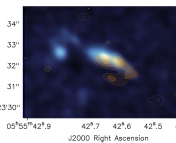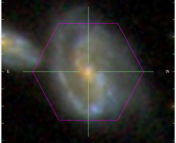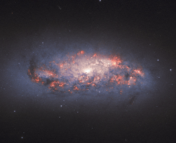Authors: Corentin Schreiber, Ivo Labbé, Karl Glazebrook et al.
First Author’s Institution: Leiden Observatory, Leiden University
Status: Published in A&A, open access on arXiv
AND
Authors: J.M. Simpson, Ian Smail, Wei-Hao Wang et al.
First Author’s Institution: Academia Sinica Institute of Astronomy and Astrophysics,
Status: Published in ApJ letters, open access on arXiv
Today’s astrobite is a story of two papers, two research groups – and perhaps, two galaxies.
It starts with this previously-astrobitten Nature paper, which announced the discovery of a massive, quiescent (i.e. no longer star-forming) galaxy at a surprisingly high redshift of z = 3.7. Surprising, because in order to form a red-and-dead galaxy at such high z, it must have undergone a significant and sudden burst of star formation at a very early time in the history of the universe. This, the authors claimed, challenges current models of galaxy evolution, in which we don’t expect to see galaxies like this until much later.
This is already controversial — as the previous astrobite points out, theorists quickly leapt to defend their models, showing that while these galaxies are rare, it is not at all impossible to create them in cosmological simulations.
However, shortly after publication, another group of observational astronomers (Simpson et al.) suggested that in fact, the authors of the original paper hadn’t seen a quiescent galaxy at all. Rather, they just hadn’t accounted for the fact that the galaxy also contained a lot of dust, only visible in long-wavelength submillimetre observations. Simpson et al.’s paper presents such observations, identifying an incredibly dusty, star-forming component very close to the optical position of the original galaxy. They argue that the spectral features that the original group had used to identify the galaxy’s quiescent nature (specifically, the Balmer lines from hydrogen atoms) are actually also found in dusty star-forming galaxies, and that by neglecting the newly discovered dusty component, they might have misjudged the mass of the galaxy, too. This means that the galaxy is neither remarkably massive nor quiescent, and not nearly such a problem for galaxy evolution models.
In response, the authors of the original paper published a follow-up (Schreiber et al.) including the submillimetre observations of this object. With the new data, they identify two distinct galaxies, one quiescent and one dusty (which they somewhat ironically call Jekyll and Hyde — unarguably, though, an improvement on the original mouthful, ZF-COSMOS-20115). Because of the heavy dust obscuration, Hyde didn’t show up at all in the optical observations that they had used to identify Jekyll, and so had been missing from the original paper. They determine that these two sources are separate galaxies, and therefore “can be considered as two closed boxes with no exchange of matter”: meaning that the discovery of Hyde and its dusty properties does not significantly affect the original conclusion that Jekyll is massive and quiescent. Since these two galaxies are separate, we have not one but two remarkable objects! The authors suggest that since Jekyll and Hyde are remarkably similar in mass and environment, they provide an interesting example of two galaxies that are perhaps on the same evolutionary path of star formation quenching in the early universe, with star-forming Hyde lagging behind quiescent Jekyll by a few hundred megayears.
This conclusion can only be drawn if the sources are indeed two independent galaxies and not two faces of one singular galaxy. If the latter were true, then the star formation history would be much more complicated, and the galaxy would not truly be quiescent.
Additionally, even if they are separate galaxies, the fact that they are so close together on the sky makes determining their masses and star formation histories very difficult.
Figure 1 shows images from both the Simpson et al. and Schreiber et al. papers on the left and right respectively. Because the sources are so close on the sky (0.4 arcseconds, which corresponds to a separation of 3kpc), the emission from the two components is blended together, and separating them meaningfully is tricky. Taking this into account, Schreiber et al.’s corrected stellar mass for Jekyll is 30% lower than the original estimate, which poses slightly less of a challenge to galaxy evolution models. Nevertheless, the Jekyll/Hyde system is certainly very interesting as a probe of galaxy formation in the early universe.

Figure 1. Images in the optical, infrared and submillimetre from both the Simpson et al. paper (left) and the Schreiber et al. paper (right). Both show HST optical images, with the overlaid contours showing infrared and submillimetre on the left-hand image, and ALMA submillimetre observations on the right. The inset panels on the right image show, from left to right, the point spread functions of the ALMA and HST, the de-convolved images, and the velocity fields. The two components are separated by ~0.4 arcseconds, or 3kpc. Figure 1 in each paper.
Despite their differences, the authors from both groups agree on one thing: high-resolution infrared imaging with the James Webb Space Telescope will, in the future, bring us closer to understanding star formation in galaxies at high redshift, which in turn will constrain models of galaxy evolution. There is still much to learn about this system’s structure and formation that better infrared observations may reveal. Bring on March 2021!*
*JWST expected launch date at time of writing




